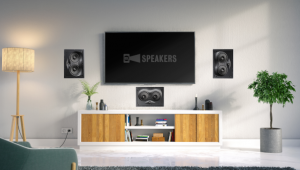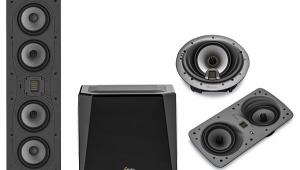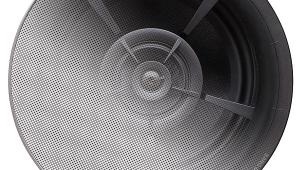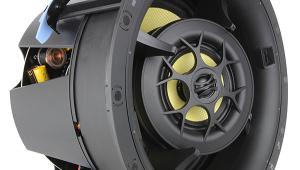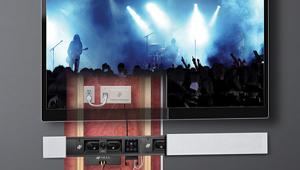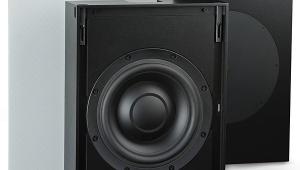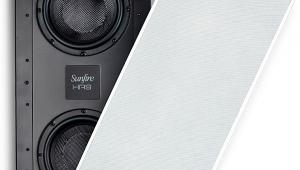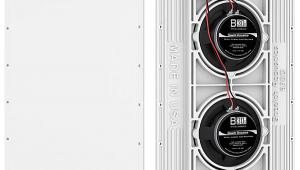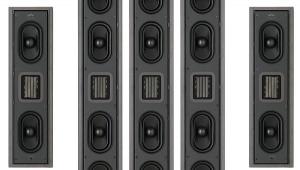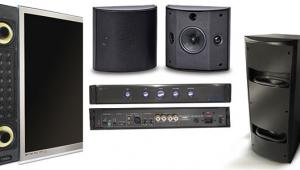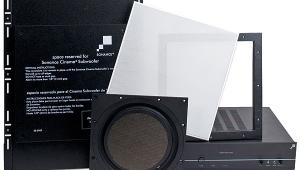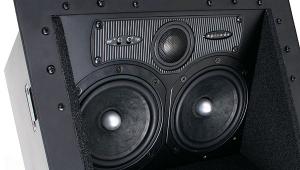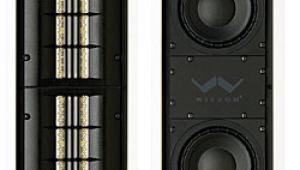Triad DS500 In-Wall Speaker System Page 2
Pucky for You
Those hockey-puck-like devices on the back of the speaker panels are a key part of a flat-transducer technology developed by NXT. Triad says the drive devices are made with the finest rare-earth neodymium-iron-boron magnets. (I’m not a connoisseur of rareearth magnets, so I’ll just take Triad’s word for it.) Technically, the drive devices are known as steered flux exciters. It may sound like a cattleman’s euphemism for what it takes to get the stud bull to do his duty, but it’s actually a fancy term for a “heavy metal disc that vibrates.” Since the drive devices are directly connected to the paper-covered honeycomb core on the front of the speaker, the vibrations transfer to the rectangular surface and then launch into the room. The principle is similar to that of a piano or guitar, where the soundboard amplifies the strings’ vibration. (Of course, piano soundboards aren’t covered with plaster or wallpaper.)

Aside from the obvious benefits of shallow depth requirements and total stealth, the distributed mode NXT flat speaker technology produces non-minimum phase sound with extremely diffuse dispersion. This is helpful since you don’t always have the best choice in terms of wall location. In my case, the wall where I wanted to install the DS500s has a large picture window right where I wanted the speakers to go. If I installed the speakers on each side of the window, they’d be about 15 feet apart. I thought this would create a large hole in the center of the image, but after Triadian Continuum assured me it would be OK, I installed a speaker on either side of the window. I prayed that the advice was good because you don’t get a second chance once the holes are cut. However, if you move or remodel, you can scrape the plaster off and reuse the speakers.
Master Plaster
At the beginning, installing the DS500 is the same as installing a standard in-wall speaker. You cut a hole, run the wire, and screw in the speaker. However, unlike traditional in-walls, the DS500 doesn’t have integral dog legs or other built-in clamping devices. Instead, each speaker comes with four installation lugs. Each lug is a small, rectangular piece of wood (or wood-like substance) with notches on opposite ends that are covered by pieces of black foam. You place the lug behind the drywall in each corner of the speaker opening, and two drywall screws hold it in place. Since the notches are at different depths, you can use the lugs with both 0.5-inch and 0.63-inch drywall. Once you’ve secured all four of the lugs, you use drywall screws to hold the corners of the speaker to the exposed portion of the lugs. The foam pads cushion the speaker baffle and make it easy to adjust the panel’s depth in relation to the surface of the wall it’s mounted in. This creates a uniform flat surface, so you won’t see a large hump.
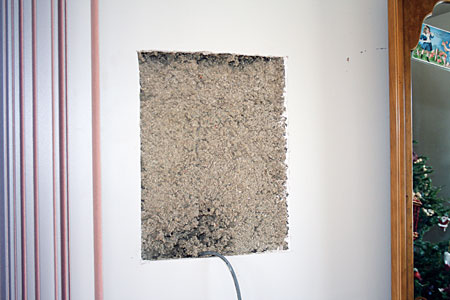



As with any in-wall speaker that isn’t completely sealed, the DS500 generates sound waves forward into the room and backward into the wall. Even though I installed the DS500s on the inside of an exterior wall, I was concerned about sound bleedthrough since that wall directly faces my neighbors’ house. To keep my neighbors from constantly calling to complain about the noise (thus causing me to write a bad review), the Triadians graciously shipped me a pair of DesignerSeries BackBoxes that fit in the wall behind the speakers and absorb the rear-firing sound. I listened to the installed (but not plastered) DS500s with and without the BackBoxes. The BackBoxes cut the sound bleeding into the yard by about half. As they say, good back boxes make good neighbors.
Next, it was time to tape, float, plaster, sand, and paint. (At least I think it was in that order; I didn’t do it.) Fortunately, I found a competent and conscientious crew, even though I have a terrible history with contractors. During the last couple of years, many contractors who returned my calls for an appointment never showed up. Of those who did show up, most of them developed serious diseases—like the guy who had to have his gall bladder taken out halfway through remodeling my theater room. I even had one painter who canceled because his artificial knee was acting up. (No, I’m not kidding.) I’m sure the way I explained the project over the phone didn’t help: “I need you to slather a one-sixteenth-inch layer of plaster over some flat speakers I mounted in the wall, and then sand and paint over them so I can hear what they sound like.” Despite their incredulity, the crew persevered. After a terrific paint job, they actually made the speakers disappear into the wall. Now I just have to make sure I don’t nail a hole in one when I try to hang a picture.








OK, the speakers aren’t totally invisible. If you stand at the right angle and the light is just right, you can see a rectangular outline where the wall was patched. It didn’t help matters that we cut the holes a bit bigger than they needed to be. But from any other angle in any other light, you wouldn’t know that there were speakers in the wall. I suppose it’s possible that someone with better install skills and even more drywall-patching finesse could make these things 100percent invisible. Still, my guys and I delivered a pair of speakers that are 99.9-percent invisible. That’s pretty damn incredible.
- Log in or register to post comments
